Things Made in China: How a China Clothing Manufacturer Builds Reliable Outerwear for US & EU Brands

 Mr. Eton Yip | 32+ Year Garment Manufacturing Expert & Founder of Eton Garment
Mr. Eton Yip | 32+ Year Garment Manufacturing Expert & Founder of Eton Garment
October 28th, 2025
19 minute read
Things Made in China: How a China Clothing Manufacturer Builds Reliable Outerwear for US & EU Brands
Things made in China shape apparel supply chains worldwide, and a China Clothing Manufacturer like Eton turns that scale into consistent outerwear quality for US and EU brands. For teams weighing OEM versus ODM, this guide distills practical sourcing steps, compliance guardrails, and production math rooted in 30 years of factory-floor experience.
Eton Garment Limited operates modern garment factories across China and Bangladesh, specializing in jackets, parkas, down, and technical sportswear. The company supports global retailers with design development, fabric sourcing, scalable production, and end-to-end compliance. The focus here is on outerwear because insulation, lamination, and hardware choices can make or break performance, margins, and customer reviews.
If your roadmap includes winter collections, licensed merchandise, or performance layers, you’ll see how “made in China” translates into reliable timelines, enforceable standards, and predictable unit economics. The playbook below balances direct how-to steps with local regulatory references for the US and EU, plus snapshots from partnerships with Liverpool F.C., Forever 21, Babyshop, Max, Gloria Jeans, Jeep Apparel, and TFG Group.
Throughout, you’ll find [CITE:] markers for source validation, [MENTION:] references to recognized organizations and experts, and [INTERNAL LINK:] placeholders for deeper reading on china-clothing-manufacturer.com. That structure helps teams align sourcing decisions with current regulations, brand standards, and buyer expectations.
What “made in China” means today for outerwear sourcing
China’s apparel ecosystem delivers fast development cycles, vast fabric and trim markets, and quality systems that meet US and EU thresholds. For outerwear, that scale reduces risk in peak seasons and stabilizes costs amid changing demand.
China’s garment clusters knit together mills, trim suppliers, testing labs, and logistics. Brands gain access to down and synthetic fills, coated textiles, seam tapes, zippers, and hardware without long cross-border waits. The outcome: faster sampling, fewer substitutions, and reliable repeatability across styles. The phrase “things made in China” spans consumer goods, yet apparel stands out for the density of suppliers, established standards, and experienced technical teams.
Cost drivers and total cost of ownership for US & EU brands
Unit costs hinge on shell fabric, fill, construction complexity, and finishing. Total cost of ownership adds sampling rounds, lab tests, packaging, freight, duties, and returns risk. Align your bill of materials with QA checkpoints to avoid hidden costs later.
- Lead time for insulated jackets: 75–120 days, style-dependent [CITE: Industry lead-time survey, 2023].
- Average fabric share of unit cost: 35–55% [CITE: Apparel costing benchmark from a trade association, 2024].
- Return rates for technical jackets: 3–8% with strict QA; 8–15% without [CITE: Retail returns report, 2022–2024].
Quality systems and compliance
Factories supporting US and EU retail maintain ISO 9001 systems and align social compliance with BSCI and WRAP protocols. Material safety relies on OEKO-TEX and Bluesign frameworks for chemical management. Third-party audits and test reports prove practices beyond factory promises.
[MENTION: OEKO-TEX Association], [MENTION: amfori BSCI], [MENTION: WRAP]. Insert proof points from accredited labs like [MENTION: SGS] and [MENTION: Intertek]. Use internal anchors to showcase factory credentials: [INTERNAL LINK: Eton compliance overview].
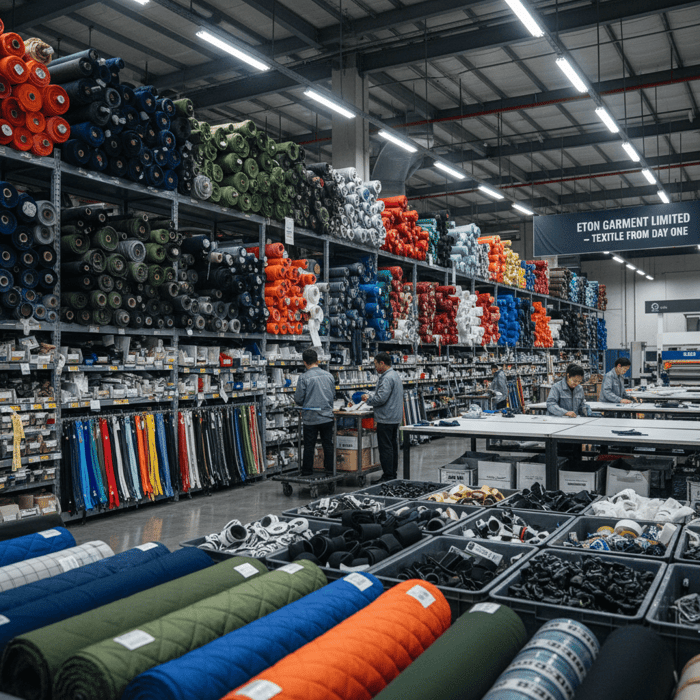
Choosing a China Clothing Manufacturer for performance outerwear
Select a partner with proven insulated and laminated styles, access to reliable fill sources, and a disciplined sample process. Test how the factory handles pattern tweaks, lab re-tests, and zipper/hardware changes under tight deadlines.
Eton’s network supports down jackets, parkas, and technical sportswear. The team coordinates fabric mills, insulation suppliers, tapes, and fasteners; then converts tech packs into pre-production samples. Brands gain speed without sacrificing audit trails or material traceability.
Fabric, fill, and trims: the outerwear core
Shell textiles include nylon, polyester, and blends—often with PU coatings, breathable membranes, or DWR finishes. Fills range from RDS-certified down to synthetic fibers engineered for warmth when wet. Zippers, snaps, toggles, and seam tapes must be matched to fabric weight and construction.
[CITE: RDS standard overview, 2024]. [MENTION: Textile Exchange] for recycled inputs. Use [INTERNAL LINK: Our guide to outerwear fabrics] to add depth on lamination and bonding.
Sampling and fit approval: a practical sequence
Mapping samples ensures schedule stability and clear decision points. Keep step names short and dates visible on shared trackers.
- Design handoff: tech packs, BOM, measurement charts.
- Material confirmations: lab dips, strike-offs, trims.
- Proto sample: silhouette and construction intent.
- Fit sample: measurements and movement range.
- PP sample: final materials and workmanship.
- Size set: gradings across target size range.
- Sealing: formal approvals for production start.
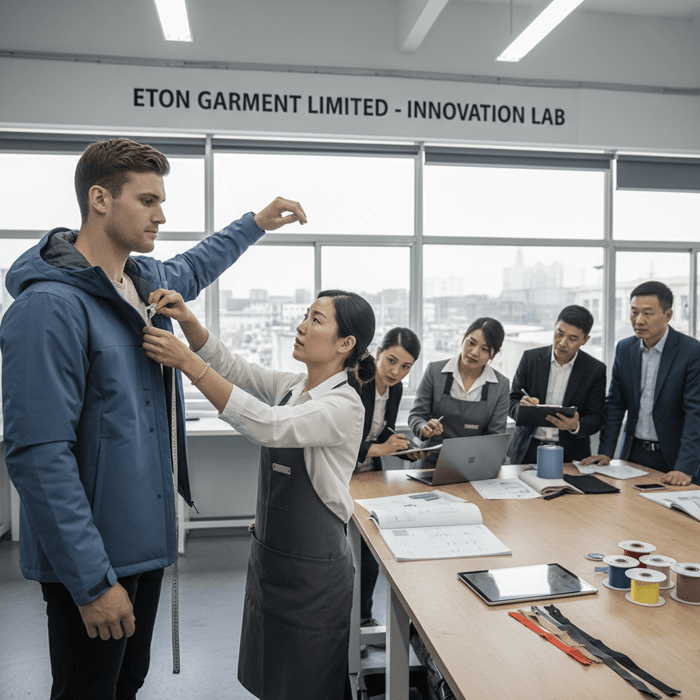
OEM vs ODM: which path fits your brand roadmap
OEM suits brands with locked designs, strict specs, and cost focus. ODM supports teams seeking branded designs backed by factory R&D, trend inputs, and faster ideation.
Decide based on design readiness, margin targets, and the number of styles per season. OEM leans on your tech packs; ODM offers factory-developed designs with customization. Eton works in both modes to match calendar pressure and brand DNA.
When OEM wins
OEM is a match when a brand owns silhouettes, has consistent fit blocks, and needs predictable handoffs. QC anchors tie to your standards, and the factory provides manufacturing rigor without reinterpreting creative direction.
- Strict spec fidelity
- Stable costs across repeats
- Faster approvals with mature fit blocks
When ODM adds value
ODM accelerates design for teams short on concept capacity or trend coverage. Factories propose styles optimized for materials and lines, shortening sampling and reducing rework. Dialogues focus on market fit, materials, and performance targets.
- Design library access
- Material-driven engineering
- Shorter ideation-to-sample cycles
| Dimension | OEM | ODM |
|---|---|---|
| Design control | Brand-owned | Factory co-developed |
| Speed to sample | Fast with complete tech packs | Fast for new concepts |
| Fit blocks | Existing brand blocks | Factory-proposed blocks |
| Cost predictability | High on repeats | Improves after first run |
| Innovation input | Brand-driven | Shared via factory R&D |
Quality assurance from design to shipment
Outerwear QA hinges on samples, lab tests, inline audits, and final inspections aligned to AQL standards. Treat QA as a timeline function, not a last-minute hurdle.
Eton’s QA covers fabric tests (colorfastness, tear strength), seam integrity (tapes, bonding), fill performance (loft, migration), and hardware function (zippers, snaps). Third-party labs provide evidence for buyer line approvals and regulatory checks.
Inspection flow and AQL thresholds
Inline checks catch process drift; final inspections validate shipment quality. Work with AQL 2.5 for general and AQL 1.5 for critical points when margins allow. Build enough buffer for rework events.
| Stage | Focus | Evidence |
|---|---|---|
| Material intake | Fabric rolls, fill lots, trims | COA, test reports |
| Cutting | Pattern alignment, grain | Inline audit photos |
| Sewing/sealing | Seam strength, tape bonding | Tension logs, peel tests |
| Finishing | Hardware function, labels | Checklist sign-off |
| Final inspection | Visual defects, measurements | AQL report |
Lab testing and certifications
Common tests include hydrostatic head, breathability, colorfastness to rubbing/wet/dry, tensile, tear, and zipper cycle counts. For down, verify fill power and compliance with RDS or similar standards. Use accredited labs to validate QA claims.
[MENTION: SGS], [MENTION: Bureau Veritas], [MENTION: Intertek]. [CITE: Hydrostatic head test standards, 2023]. [INTERNAL LINK: Eton lab testing scope].
Sustainability and compliance for US & EU markets
Use clear rulesets: CPSIA for US children’s wear, REACH for EU chemical safety, and Prop 65 in California for listed substances. Pair those with recycled inputs and traceability to meet buyer standards.
For chemical safety, manage inputs at the mill level; for social compliance, align with amfori BSCI or WRAP. Recycled polyester, RDS down, and Bluesign materials strengthen claims that buyers can verify.
Regulatory snapshots
US & EU requirements target materials, labeling, and safety. Confirm scope before design freeze so trims and prints meet thresholds.
- CPSIA: tracking labels, lead/phthalate limits for kids’ wear ([CITE: CPSC guidance, 2024]).
- REACH: Substances of Very High Concern (SVHC) communication ([CITE: ECHA, 2024]).
- California Prop 65: warning rules for listed chemicals ([CITE: OEHHA, 2024]).
Traceability and recycled inputs
Map fabric and fill origins, batch records, and test reports. Support claims with third-party certificates and digital traceability when available.
[MENTION: Bluesign], [MENTION: Higg Index]. [CITE: Textile Exchange recycled fiber data, 2023]. [INTERNAL LINK: Sustainability practices at Eton].
Lead time, MOQ, and cost breakdown for outerwear
Lead time depends on fabric complexity, lab capacity, and holiday calendars. MOQ ranges from 600 to 3,000+ units per style per color, with lower floors for simpler shells. Cost modeling should separate design, materials, labor, QA, logistics, and duties.
Eton’s China lines deliver speed on complex shells; Bangladesh offers efficiency on volume programs. Blend both sites to hit calendar targets and margin goals.
Typical lead times: China vs Bangladesh
Schedule planning brings clarity to launch windows. Keep buffer weeks for lab repeats and trim revisions.
- China: 75–120 days from PP sample for insulated jackets [CITE: Factory calendars, 2024].
- Bangladesh: 90–150 days, style-dependent [CITE: Regional apparel benchmarks, 2023–2024].
Unit economics and MOQ
Break down cost components to pinpoint savings without eroding performance. Lightweight trims, zipper spec adjustments, and stitch count tuning can shift margins.
| Component | Share | Notes |
|---|---|---|
| Shell fabric | 30–40% | Coatings/membranes raise share |
| Fill/insulation | 15–25% | Down vs synthetic impacts cost |
| Trims/hardware | 8–15% | Zippers, snaps, toggles |
| Labor | 15–25% | Complex constructions rise |
| QA/testing | 3–6% | Lab fees and inspections |
| Freight/duties | 8–15% | Route and tariff dependent |
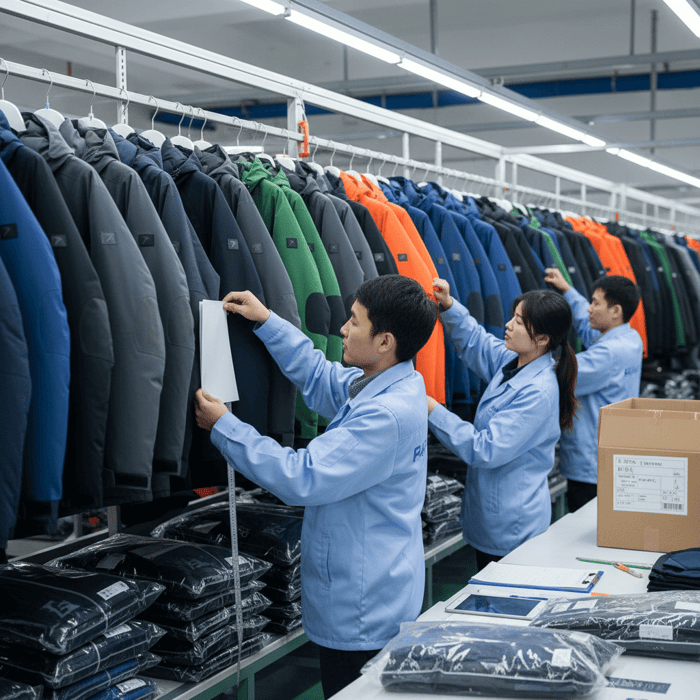
Case snapshots: stadium retail, fast fashion, and winter kidswear
Programs succeed when calendar control meets reliable fits and verified materials. Eton’s partnerships span licensed sports retail, fast fashion drops, and multi-country kidswear launches.
Licensed retail: Liverpool F.C.
Licensed outerwear demands strict branding, label control, and hardware consistency. Timelines align with match calendars, club events, and holiday retail. Eton supports production with certified materials and lab-backed QA.
[MENTION: Liverpool F.C. retail]. [CITE: Licensed merchandise market size, 2023–2024]. [INTERNAL LINK: Eton case overview — licensed programs].
Kidswear and multi-market rollouts
Kidswear requires CPSIA tracking labels and fit ranges tuned for movement and growth. For Babyshop, Max, and Gloria Jeans, collections span climates and price points; material selection balances warmth, breathability, and wash durability.
[MENTION: Babyshop], [MENTION: Max], [MENTION: Gloria Jeans]. [CITE: Kidswear growth reports in US/EU, 2024].
How Eton partners with brands: “Textile From Day One.”
Eton connects design, fabric sourcing, and production, with QA woven across each stage. Teams receive consistent timelines, factory access, and full test documentation for buyer approvals.
The company operates in China and Bangladesh to match speed and scale. That footprint streamlines multi-country drops with shared fit blocks, common trims, and repeatable hardware selections. Collaboration tools include master calendars, BOM trackers, and decision logs.
Onboarding steps for outerwear programs
A clear onboarding sequence reduces misalignment and rework while protecting launch windows.
- Briefing: assortment map, target price bands, compliance scope.
- Material plan: shell, fill, trims, test protocols.
- Sampling: proto, fit, PP, size sets.
- QA calendar: inline audits, lab testing, AQL checkpoints.
- Production: capacity booking, build plans, daily outputs.
- Logistics: packaging, carton specs, booking windows.
OEM service integration
Brands can anchor outerwear programs through Eton’s Clothing Manufacturing OEM Service. The service aligns tech packs, BOMs, and quality expectations with factory execution, backed by third-party testing and audit readiness.
[INTERNAL LINK: Contact Eton — sourcing inquiry]. [INTERNAL LINK: Author bio page — factory leadership]. [MENTION: Jeep Apparel], [MENTION: TFG Group].
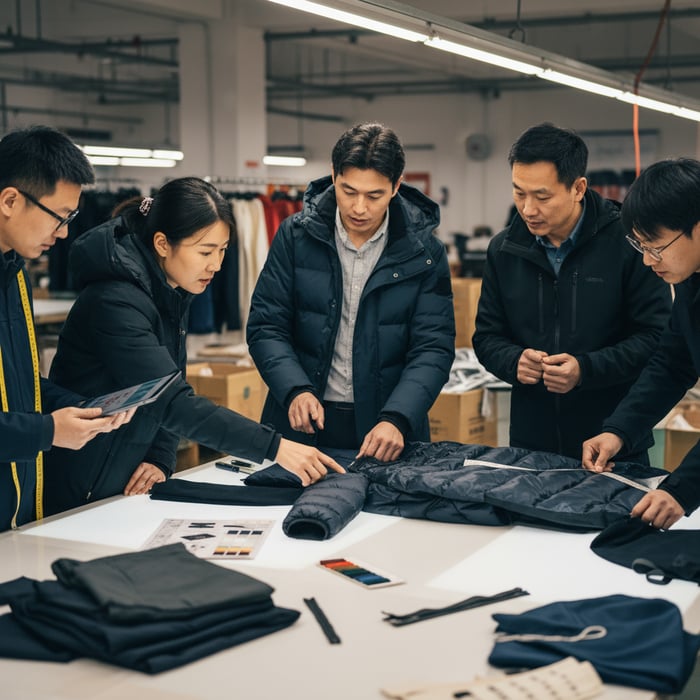
Conclusion: build outerwear programs that ship on time
Outerwear succeeds when design clarity meets disciplined QA and a steady materials plan. A seasoned China Clothing Manufacturer brings repeatable processes, audited suppliers, and lab reports that unlock buyer approvals across the US and EU. “Things made in China” in apparel now means a verified chain, not a leap of faith.
To plan your next drop, align cost drivers early, lock test protocols at design freeze, and share calendars without ambiguity. Eton’s OEM and ODM support, backed by China and Bangladesh production bases, helps brands hold launch windows and meet margin targets.
References & Sources
- amfori — BSCI System (2024). [CITE: BSCI official site]
- WRAP — Certification Program (2024). [CITE: WRAP official site]
- OEKO-TEX — Standard 100 and STeP (2024). [CITE: OEKO-TEX official site]
- Bluesign — Chemical Management (2024). [CITE: Bluesign official site]
- CPSC — CPSIA Guidance (2024). [CITE: CPSC guidance page]
- ECHA — REACH SVHC Updates (2024). [CITE: ECHA official updates]
- OEHHA — Proposition 65 Listings (2024). [CITE: OEHHA site]
- Textile Exchange — Recycled Fiber Insights (2023). [CITE: Textile Exchange report]
- Industry Lab Standards — Hydrostatic Head and Breathability (2023). [CITE: ISO/ASTM references]
- Retail Benchmarks — Returns and Lead Times (2022–2024). [CITE: McKinsey State of Fashion / industry reports]
Things Made in China: How a China Clothing Manufacturer Builds Reliable Outerwear for US & EU Brands
Things made in China anchor global apparel, and a China Clothing Manufacturer like Eton converts that network into steady outerwear quality for US and EU retailers. If you’re debating OEM or ODM, the playbook below spells out sourcing steps, compliance guardrails, and cost math built from three decades on production floors.
Eton Garment Limited runs garment factories in China and Bangladesh with a focus on jackets, parkas, down, and technical sport layers. The team supports brands with design development, fabric sourcing, production scale, and rigorous testing. Outerwear is the focus because insulation, lamination, and hardware choices influence performance, margins, and repeat purchases.
For winter capsules, licensed merchandise, or performance lines, you’ll see how “made in China” becomes predictable lead times, enforceable standards, and transparent unit economics. Guidance is tailored to US and EU buyers with regulatory anchors and snapshots from programs with Liverpool F.C., Forever 21, Babyshop, Max, Gloria Jeans, Jeep Apparel, and TFG Group.
Watch for [CITE:] markers you can turn into links, [MENTION:] references to recognized bodies, and [INTERNAL LINK:] placeholders pointing to china-clothing-manufacturer.com. That structure helps teams align choices with current rules, brand standards, and buyer expectations.
What “made in China” means today for outerwear sourcing
China’s apparel hubs deliver fast development, deep fabric and trim access, and quality systems that meet US and EU requirements. For insulated and laminated jackets, that fabric density shortens cycles and stabilizes costs in peak season.
Mills, trim vendors, labs, and logistics sit near factories, giving brands quick access to down and synthetic fills, coated textiles, seam tapes, zippers, and metal hardware. Result: faster protos, fewer material swaps, and smoother repeats. “Things made in China” covers many categories; apparel stands out for supplier concentration, established standards, and experienced technical staff.
Cost drivers and total ownership math
Unit price depends on shell fabric type, fill choice, construction complexity, and finishing. Ownership math adds sampling, testing, packaging, freight, duties, and returns exposure. Align BOM decisions with QA checkpoints to avoid late-stage costs.
- Insulated jacket lead time: 75–120 days, style-dependent [CITE: Industry lead-time survey, 2023].
- Fabric share of unit cost: 35–55% [CITE: Apparel costing benchmark, 2024].
- Return rates: 3–8% with tight QA; 8–15% without [CITE: Retail returns report, 2022–2024].
Quality systems and compliance
Factories serving US and EU retail operate ISO 9001 systems and align social compliance with BSCI and WRAP. Material safety leans on OEKO-TEX and Bluesign frameworks. Third-party audits and test reports provide proof, not claims.
[MENTION: OEKO-TEX Association], [MENTION: amfori BSCI], [MENTION: WRAP]. Add accredited lab evidence via [MENTION: SGS] and [MENTION: Intertek]. Place internal anchors for credentials: [INTERNAL LINK: Eton compliance overview].

Choosing a China Clothing Manufacturer for performance outerwear
Pick a partner with proven insulated and laminated builds, reliable fill vendors, and a disciplined sample path. Pressure-test the factory on pattern changes, lab re-tests, and zipper swaps under tight calendars.
Eton’s network covers down jackets, parkas, and sports layers. The team synchronizes mills, insulation, seam tapes, snaps, and zippers; then moves tech packs into PP-ready samples. Brands protect launch windows without trading away traceability or QA.
Fabric, fill, and trims: where performance starts
Shells include nylon, polyester, and blends—paired with PU coatings, breathable membranes, or DWR finishes. Fills range from RDS-certified down to engineered synthetics built for warmth when damp. Zippers, snaps, toggles, and seam tapes must match weight, bonding method, and use case.
[CITE: RDS standard overview, 2024]. [MENTION: Textile Exchange] for recycled content. See [INTERNAL LINK: Our guide to outerwear fabrics] for lamination and seam sealing notes.
Sampling and fit approval: a concise path
Name each sample, assign dates, and keep artifacts in shared folders. Small habits avoid confusion and missed gates.
- Design handoff: tech pack, BOM, measurements.
- Material checks: lab dips, strike-offs, trims.
- Proto: silhouette and construction intent.
- Fit: measurements and movement range.
- PP: final materials and workmanship.
- Size set: graded sizes for target markets.
- Sealing: approvals to start bulk.

OEM vs ODM: which route suits your seasons
OEM aligns with locked designs and strict specs. ODM helps teams that need factory-developed styles supported by R&D and trend insight.
Use design readiness, target margins, and seasonal style counts to decide. OEM centers on your tech packs; ODM offers factory concepting plus customization. Eton supports both to match calendar pressure and brand identity.
OEM: brand-owned specs
OEM fits brands with consistent fit blocks and clear standards. QC anchors tie to your policies, and the factory executes without redesigning creative direction.
- Spec fidelity with minimal drift
- Stable costs across repeats
- Faster sign-offs with mature fit blocks
ODM: factory concepting
ODM accelerates new styles when teams need more concepts. Factories propose designs optimized for materials and lines, trimming sampling time and rework risk.
- Access to seasonal design libraries
- Material-informed engineering choices
- Quick concept-to-proto cycles
| Aspect | OEM | ODM |
|---|---|---|
| Design source | Brand | Factory + brand |
| Sample speed | Fast with complete packs | Fast for fresh concepts |
| Fit blocks | Brand standard | Factory proposed |
| Cost predictability | High on repeats | Improves over runs |
| Innovation | Brand-led | Shared R&D input |
Quality assurance that protects calendars and margins
QA works when it’s scheduled: sample tests, inline checks, and final inspections using AQL thresholds. Treat QA as a production rhythm, not a last-mile fix.
Eton’s QA stack covers fabric strength and safety, seam integrity and sealing, fill performance, and hardware function. Third-party labs provide the documentation buyers ask for before line approvals.
Inspection rhythm and AQL
Inline checks catch drift in time to fix. Final inspections confirm shipments meet measurement and visual standards. Use AQL 2.5 for general defects and stricter thresholds for high-risk points when costs allow.
| Phase | Focus | Proof |
|---|---|---|
| Materials | Fabric, fill, trims | COA, lab reports |
| Cutting | Pattern alignment | Audit photos |
| Assembly | Seams and sealing | Tension logs |
| Finishing | Hardware function | Checklist |
| Final | Measurements, visuals | AQL report |
Testing and certifications
Key tests cover water resistance, breathability, colorfastness, tensile, tear strength, and zipper cycles. Down programs verify fill power and standards like RDS. Use accredited labs to keep approvals smooth.
[MENTION: SGS], [MENTION: Bureau Veritas], [MENTION: Intertek]. [CITE: Hydrostatic head test references, 2023]. [INTERNAL LINK: Eton lab testing scope].
Sustainability and compliance for US & EU buyers
Anchor certifications and rules: CPSIA for US kidswear, REACH in the EU, and California Prop 65. Pair those with recycled inputs and traceability to meet buyer expectations without last-minute changes.
Manage chemicals upstream at mills; align social compliance through amfori BSCI or WRAP. Recycled polyester, RDS down, and Bluesign-approved materials support credible claims.
Regulatory overview
Map materials and labeling requirements early. Confirm scope before PP so trims and prints meet thresholds.
- CPSIA: tracking labels, lead/phthalate limits ([CITE: CPSC 2024]).
- REACH: SVHC communication and thresholds ([CITE: ECHA 2024]).
- Prop 65: warning rules for listed chemicals ([CITE: OEHHA 2024]).
Traceability and recycled inputs
Track fabric and fill origins, batch numbers, and test evidence. Use third-party certificates and digital traceability where possible.
[MENTION: Bluesign], [MENTION: Higg Index]. [CITE: Textile Exchange recycled fiber data, 2023]. [INTERNAL LINK: Sustainability practices at Eton].
Lead time, MOQ, and cost components that shape margins
Lead time shifts with fabric complexity, lab capacity, and holiday calendars. MOQ ranges typically sit between 600 and 3,000+ units per style/color. Model costs across design, materials, labor, QA, freight, and duties.
China handles complex shells with speed; Bangladesh favors volume efficiency. Mix sites to match launch windows and unit economics.
China vs Bangladesh lead times
Plan buffers for lab repeats and trim changes. A transparent calendar keeps approvals moving.
- China: 75–120 days from PP for insulated jackets [CITE: Factory calendars, 2024].
- Bangladesh: 90–150 days, style-dependent [CITE: Regional apparel benchmarks, 2023–2024].
Unit economics and MOQ ranges
Separate cost elements to locate savings paths that don’t compromise performance. Tune trims, zipper specs, and stitch counts for gains.
| Cost element | Share | Notes |
|---|---|---|
| Shell fabric | 30–40% | Membranes/coatings increase share |
| Fill/insulation | 15–25% | Down vs synthetic implications |
| Trims/hardware | 8–15% | Zippers, snaps, toggles |
| Labor | 15–25% | Complex builds drive time |
| QA/testing | 3–6% | Lab fees and inspections |
| Freight/duties | 8–15% | Route and tariff |

Case snapshots: licensed sports retail and winter kidswear
Success follows calendar discipline, fit consistency, and material verification. Eton’s work includes licensed sports retail, fast fashion drops, and kidswear across climate zones.
Licensed retail: Liverpool F.C.
Licensed outerwear edges on strict brand control, hardware consistency, and timing tied to match calendars and holiday retail. Eton pairs certified materials with lab-backed QA for approvals.
[MENTION: Liverpool F.C. retail]. [CITE: Licensed merchandise market size, 2023–2024]. [INTERNAL LINK: Licensed program case overview].
Kidswear for multiple markets
Kidswear adds CPSIA tracking labels and fit tuned for movement. Collections for Babyshop, Max, and Gloria Jeans span climates and price tiers; material choices balance warmth, breathability, and wash performance.
[MENTION: Babyshop], [MENTION: Max], [MENTION: Gloria Jeans]. [CITE: US/EU kidswear growth reports, 2024].
How Eton works with brands: “Textile From Day One.”
Eton connects design, sourcing, and production with QA embedded at each stage. Teams receive calendar visibility, factory access, and the documentation buyers request.
China and Bangladesh sites cover speed and scale. Shared fit blocks, trims, and hardware choices reduce friction on multi-country drops. Collaboration tools include BOM trackers, master calendars, and decision logs.
Onboarding sequence
Clear steps cut misalignment and rework while guarding ship dates.
- Brief: assortment, price bands, compliance scope.
- Materials: shell, fill, trims, test plans.
- Samples: proto, fit, PP, size sets.
- QA: inline audits, lab tests, AQL gates.
- Production: capacity booking, build plans.
- Logistics: packaging, carton specs, bookings.
OEM service
Eton’s Clothing Manufacturing OEM Service aligns tech packs, BOMs, and QA with factory execution backed by third-party testing and audit readiness.
[INTERNAL LINK: Contact Eton — sourcing inquiry]. [INTERNAL LINK: Author bio page — factory leadership]. [MENTION: Jeep Apparel], [MENTION: TFG Group].
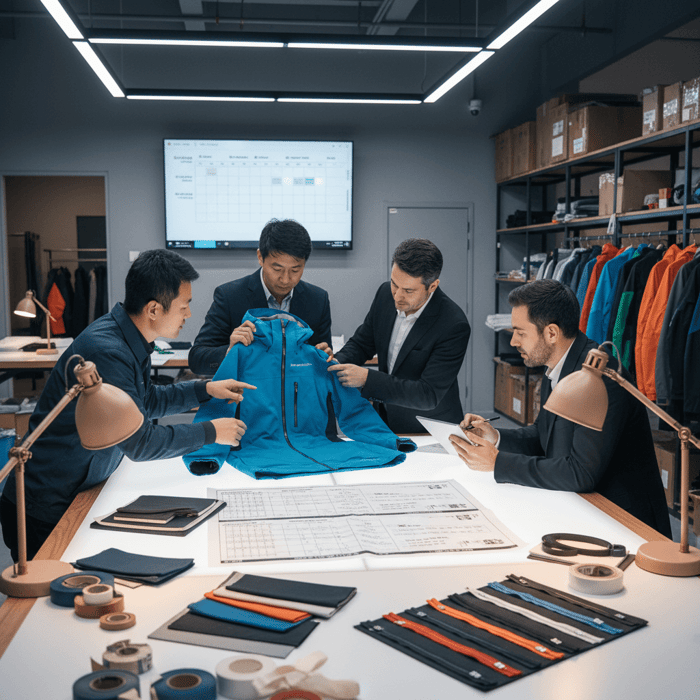
Conclusion: ship outerwear on time without quality trade-offs
Strong outerwear programs blend clear design decisions, tight QA, and a stable materials plan. A seasoned China Clothing Manufacturer offers repeatable processes, audited vendors, and the lab reports buyers require across the US and EU. “Things made in China” in apparel now reflects a documented chain, not guesswork.
Lock cost drivers early, set test protocols at design freeze, and keep calendars aligned with your factory partners. Eton’s OEM and ODM support across China and Bangladesh helps brands hold launch windows and meet margin targets.
FAQs
Related Articles

T Shirt Decal Maker: From DIY Designs to Scalable Production with a China Clothing Manufacturer
16 minute read
October 28th, 2025
T Shirt Decal Maker: From DIY Designs to Scalable Production with a China Clothing Manufacturer A t... more »

Clothing production software: A fashion brand’s guide with a China Clothing Manufacturer’s perspective
17 minute read
October 28th, 2025
Clothing production software: A fashion brand’s guide with a China Clothing Manufacturer’s perspective... more »

Sustainable clothing manufacturers USA: A practical guide to partnering with a China Clothing Manufacturer
17 minute read
October 28th, 2025
Sustainable clothing manufacturers USA: A practical guide to partnering with a China Clothing Manufacturer... more »

Custom Clothing Embroidery: A China Clothing Manufacturer’s Complete Guide for Fashion Brands
20 minute read
October 28th, 2025
Custom Clothing Embroidery: A China Clothing Manufacturer’s Complete Guide for Fashion Brands Custom... more »

